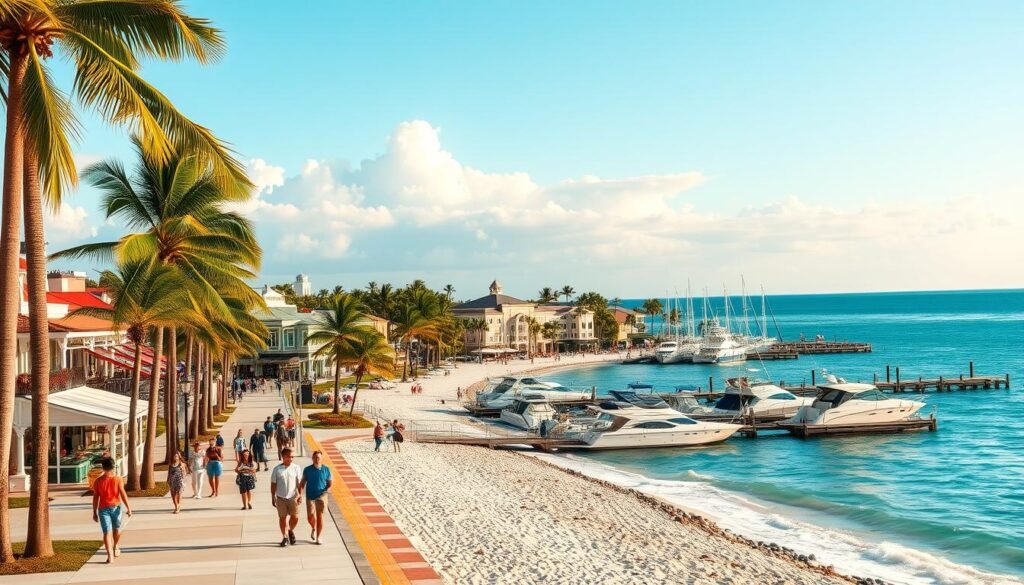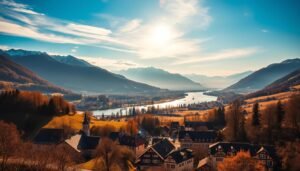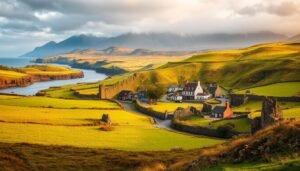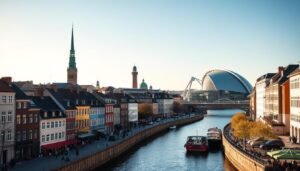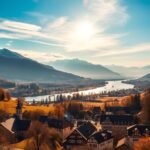Did you know a single neighborhood can hold centuries of art, food, and legend on nearly every block? I felt that pull the moment I stepped into the Centro Storico, where pizzas, chapels, and seaside promenades share the same breath.
I write as someone who plans a trip with a soft spot for markets and marble halls. I mix landmark visits—like the Royal Palace and Teatro San Carlo—with small rituals: a late afternoon walk along Lungomare and a bite of frittatina di pasta.
Expect a friendly guide that balances must-see sites and local life. I map out when to wander, when to queue, and when a paid tour makes sense for underground tunnels or catacombs.
My promise: clear, practical tips that help you enjoy the best things without rushing. This city’s history, food, and views make every moment feel lived-in, not just checked off an itinerary.
Key Takeaways
- I blend landmark highlights with everyday local spots for a fuller experience.
- Plan time by neighborhood: stroll, eat, then visit museums or castles.
- Use funiculars and timed entries to save energy and skip long queues.
- Don’t miss signature flavors like margherita and babà at trusted trattorias.
- Reserve specific tours for underground sites; wander solo elsewhere for freedom.
My First Impressions of the City’s Energy, History, and Street Life

Stepping off the tram, I was struck by how quickly the city folded past and present together. Spaccanapoli felt like a living vein: Vespas darted, neighbors shouted across balconies, and artisan shops hummed under church domes.
The air carries pizza aromas and a thousand small conversations. I watched markets pulse and realized life here is public and generous; strangers trade gossip as easily as lemons.
Sound anchors every corner: church bells, vendors calling, and a faint opera aria from an open window. The mix makes discovery feel immediate—turn a corner and a courtyard or a tiny workshop greets you.
- Baroque interiors and worn facades sit side by side.
- Layers of history show through from Greek ruins to Bourbon palaces.
- I calm my pace by picking a single street and walking slow.
This aimless stroll sets my tone for deeper visits and points me toward lively neighborhoods and hidden palazzi I can’t wait to explore.
Stroll Spaccanapoli and Via dei Tribunali to Feel Naples’ Pulse
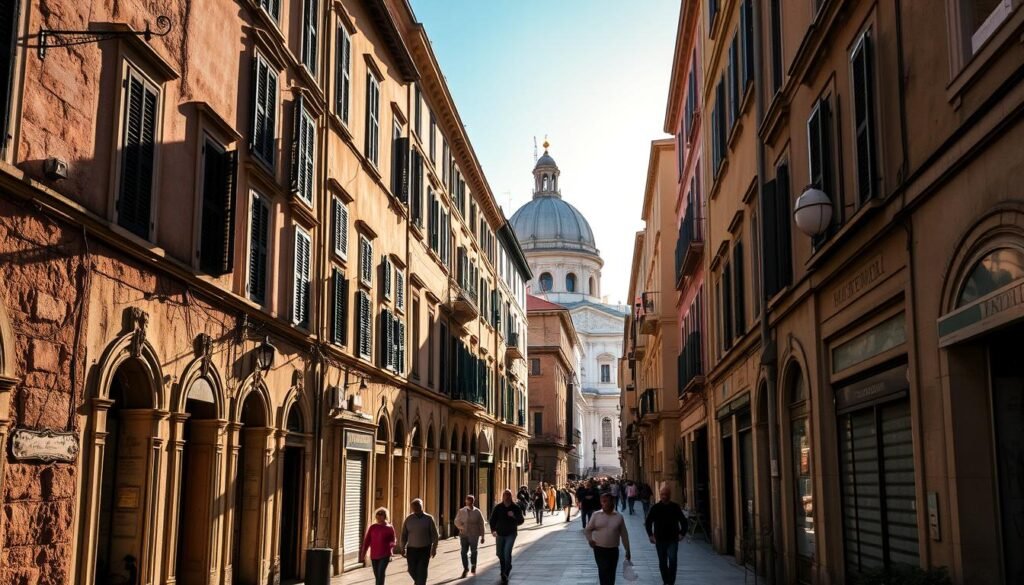
My favorite walk threads through narrow lanes where every doorway hints at a story. Start at Piazza del del gesù, slip into the church’s surprising baroque interior, then let Spaccanapoli carry you along.
Key stops: Gesù Nuovo, San Domenico Maggiore, and hidden palazzi
I time my visit for late afternoon light. San Domenico Maggiore sits by a lively square; go early for calm, late for people-watching.
Peek through grand doors into palazzi courtyards and narrow staircases. Nearby, Pio Monte della Misericordia and San Lorenzo Maggiore add art and ancient ruins if you want extras.
Don’t miss Via San Gregorio Armeno for nativity craft tradition
Via San Gregorio Armeno brims with presepi makers year-round. Watching artisans shape tiny scenes is a small ritual I never skip.best-places-to-visit-in-new-york
Evening vibes: street art, pizza aromas, and lively piazzas
Walk Spaccanapoli one way, loop back along Via dei Tribunali for churches, pizzerias, and nightlife. Be mindful of scooters, step aside for deliveries, and visit a few workshops for handmade finds.
- Simple plan: an unhurried stroll, two sacred stops, a taste of nativity craft, and an early-evening slice to set your night.
Go on a Pizza Pilgrimage through the Birthplace of Margherita

I chased my first perfect slice down a narrow street and learned how the city turns dough into ritual.
The true Neapolitan pie cooks 60–90 seconds in a wood oven at about 485°C, which gives that blistered crust I still crave. My repeat stops are Sorbillo for the buzz, L’Antica Pizzeria da Michele for the rite (since 1870), 50 Kalò for precision, and Starita for heritage.things-to-do-in-portland
Classic and elevated places I trust
Palazzo Petrucci offers seasonal toppings and rooftop or square seating over Piazza San Domenico Maggiore. For quieter options, try Concettina ai Tre Santi or La Notizia.
Pro tips on ordering and timing
- One pie per person; pizzas arrive unsliced—use knife and fork if too hot, then fold.
- Beat lines by arriving off-peak, using the takeaway window at da Michele, or booking Petrucci ahead.
- If time is short, keep a nearby backup like Di Matteo or Da Attilio.
“Plan pizza days like museum days: one marquee place and one backup.”
Feast on Street Food and Traditional Dishes Like a Local

I start my mornings where the city wakes, following the scent of fried dough and fresh catch into market alleys. Pignasecca, the oldest market, is best early when vendors call and the stalls brim with seafood and produce.things-to-do-in-atlantic-city
Market moments at Pignasecca: seafood, produce, and daily life
I graze as I go: a cuoppo of fried seafood, a hot frittatina di pasta, and a quick espresso at the bar like locals. Watch, ask before snapping photos, and carry small cash—this keeps the market vibe respectful and smooth.
What I order and where I sit
Must-tries are sfogliatella and rum-soaked babà for sweets, plus panzarotti and montanara for crisp comfort. For a proper sit-down, I favor Locanda del Gesù Vecchio, Da Nennella, and Antica Trattoria da Carmine for honest seafood.
“Eat where the line speaks Neapolitan and the menu reads like the city’s greatest hits.”
Quick route: market first, then a nearby trattoria. Street bites pair well with a slice of pizza later, letting you sample many places without spoiling your appetite.
Experience Grit and Warmth in the Spanish Quarter (Quartieri Spagnoli)
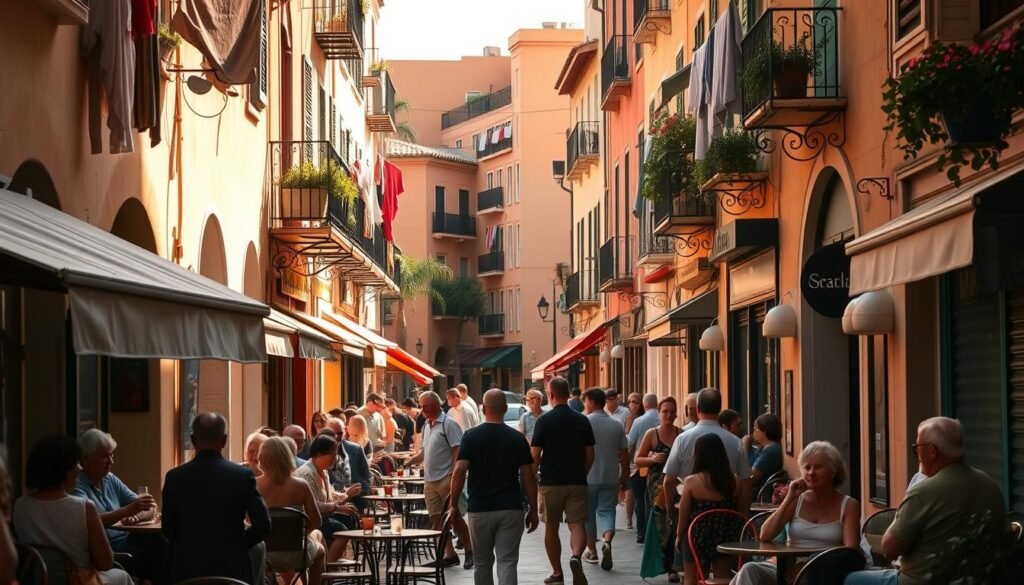
I cross into the Spanish Quarter and feel the pace change, like a new rhythm has taken hold. Narrow grids, laundry lines, and small cafés make daily life visible and lively.things-to-do-with-kids
Maradona murals on Via Emanuele De Deo and neighborhood pride
I walk Via Emanuele De Deo and stop at the Maradona murals. The art pulses with local pride, amplified after Napoli’s 2023 title win. You can touch that communal energy and see how fans keep his memory alive.
Views and vibes: Largo Baracche and everyday street scenes
The Quarter began in the 16th century as housing for Spanish troops, and that history still shapes its tight lanes. I like late afternoon best: families spill into the street, trattorias warm up, and balconies show flags and shrines.
Practical notes: the area sits next to Via Toledo and is safe with normal city caution. I often join a short local tour for background on murals, altars, and long-running businesses.
| Spot | What I see | Best time |
|---|---|---|
| Via Emanuele De Deo | Maradona murals and fan tributes | Late afternoon |
| Largo Baracche | Bay views and Castel Sant’Elmo on the hill | Sunset pause |
| Main alleys | Street life, banners, and small osterias | Evening for dinner |
“The Quarter’s grit and warmth balance the city’s grand baroque—look up; its heart is on display.”
Simple route: step off Via Toledo into the Quarter, head up toward Largo Baracche, then drop back down for dinner at Da Nennella or a nearby osteria. This short loop shows why this area feels so alive today.
Uncover the Veiled Christ at Cappella Sansevero

I found myself holding my breath as marble became veil and flesh under a single beam of light. That first moment inside Cappella Sansevero made the chapel feel alive and very small in the best way.
Why the marble “Veiled Christ” left me speechless
The veiled christ by Giuseppe Sanmartino is an 18th-century miracle of carving. The draped shroud reads as breathable fabric, yet it is stone.best-places-to-visit-in-june
Other sculptures and painted details around the tomb add layers; they reward a slow, careful look.
How I time my visit and book ahead
Book a timed slot well before your visit. I aim for the first hour or near closing to avoid the largest crowds.
- Read a short note on Sanmartino’s technique before you enter.
- Plan to linger and circle the sculptures twice rather than rushing out.
- Arrive a few minutes early for ticket scanning; spaces are tight.
“This is one of the city’s rare ‘believe the hype’ art experiences—worth every minute you give it.”
| Tip | Why it helps | Best moment |
|---|---|---|
| Timed ticket | Limits crowding and secures entry | First hour or near closing |
| Pre-read on technique | Deepens your appreciation of carving skill | Before you enter |
| Pair with coffee nearby | Gives time to reflect after the visit | After the chapel tour |
Step Beneath the City in Naples Underground and Galleria Borbonica
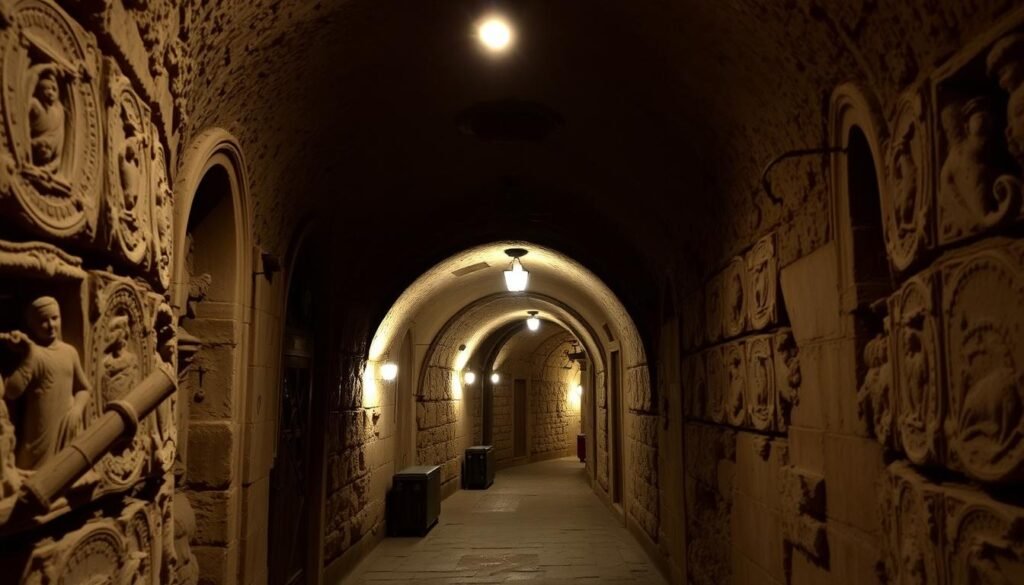
Walking below the street taught me a new map of the city—one cut into stone and memory. The underworld here has a rhythm: aqueducts, cisterns, wartime rooms, and traces of an ancient theatre.
Napoli Sotterranea leads you through Greek‑Roman aqueducts, narrow cistern passages, WWII air‑raid shelters, and fragments of the Roman theater. Galleria Borbonica was carved in 1853 as a Bourbon escape route and holds wartime shelters plus vintage vehicles left in quiet halls.
- I always book a guided tour because a local guide makes the layered history click into place.
- Pick Napoli Sotterranea for aqueducts and theater traces; choose Galleria Borbonica for Bourbon engineering and relics from a later century.
- Expect stairs and tight squeezes—this is the real way you feel the city beneath its street.
Mid‑morning slots avoid the biggest groups and keep your day flowing. Bring closed shoes and a light layer; temperatures stay cool below ground. My wow moment: WWII rooms with dated, year-stamped signs that make the past feel startlingly near.
“Book ahead, pick the route that matches your interest, and plan a surface walk afterward so the underground work you saw maps back onto the streets above.”
For details and reservations, check a trusted guide like Naples Underground tours. After the visit, I recommend a slow coffee to let the experience settle—seeing the underbelly changes how you read every corner above.
Pay Respect in the Catacombs of San Gennaro and San Gaudioso

I stood at the mouth of the catacombs and felt centuries press close, as if the city whispered its oldest prayers. Descending into the tuff-carved halls shifts how you measure time.
Ancient tombs and sacred memory
The Catacombe di San Gennaro holds over 3,000 burials hewn from tuff. Lower levels date back to the 3rd century CE and link directly to the devotion surrounding San Gennaro.
San Gaudioso and contrasting layers
San Gaudioso offers a different tone: burials tied to a 5th-century bishop and intimate frescoes. I compare both sites when I want art and burial practices side by side.things-to-do-in-kansas-city
Choosing a route and practical notes
Visits run only by guided tour and offer multiple routes, durations, and language options. Book ahead—capacity is limited and proceeds help Rione Sanità projects.
- Tip: wear closed shoes; the underground stays cool and slightly damp.
- Afterwards: plan a quiet coffee and a nearby meal so the day’s solemnity balances with local life.
Look closely for inscriptions, early-Christian symbols, and small fresco details that survive across each century. Move with care: this is a sacred place that honors both past and the living community.
For a fuller practical overview, see my complete guide to the Catacombs.
things to do in naples
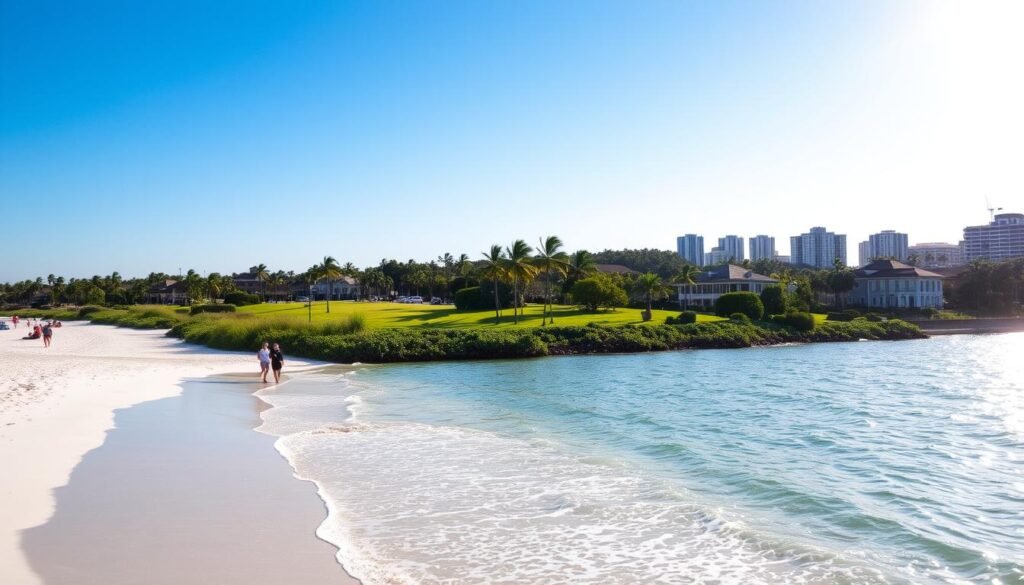
A quick loop through the historic center ties marble masterpieces with market chatter in a compact, walkable plan.
Highlights at a glance: Cappella Sansevero with the Veiled Christ, San Domenico Maggiore, and the National Archaeological Museum anchor this route.
Streets I always walk: Spaccanapoli and Via San Gregorio Armeno deliver artisan workshops and nativity makers still active today.
- Start early at cappella sansevero (book ahead) for quieter viewing of the veiled christ.
- Walk toward san domenico maggiore for light-filled chapels and a lively piazza.
- Reserve an hour at the national archaeological museum for Pompeii and classical collections.
Simple route: morning chapel, late morning museum, lunch near the artisan lanes. Save an evening for a piazza; spontaneity makes the city sing.
“Mix headline sites with everyday scenes; that balance shows the place in full color.”
Marvel at the National Archaeological Museum’s World-Class Collections
Entering the museum felt like opening a map of the ancient world, each gallery a new country of stone and color. Established in the late 18th century by King Charles VII, this house holds treasures from Pompeii and Herculaneum.
From Pompeii and Herculaneum to the Farnese marbles
Focus on marquee pieces: I aim for the Farnese marbles, the Villa of the Papyri bronzes, and the best mosaics so the vast collection feels manageable. These works link directly to the sites you’ll visit later and enrich every ruin you see.best-places-to-visit-in-california
How I plan a focused visit without burning out
- I set a rhythm by rooms: start with Pompeii/Herculaneum artifacts, then move to sculpture halls.
- I limit my visit to 90–120 minutes, take a short break, then choose one final gallery if I have energy.
- Arrive early, buy tickets ahead, and use English signage for deeper notes on each work.
“Even a short, targeted stop here pays off across your whole itinerary.”
Practical tip: pair the museum with a nearby café for a light pause. That way your time at the museum stays rich, not exhausting, and the art lodges in your memory for the rest of the day.
Seek Calm at Santa Chiara’s Majolica Cloister
The moment I step beneath the pergola, tile color and citrus scent reset my pace. The cloister feels like a painted pocket of quiet amid the city’s rush.
A quiet interlude amid tiles, citrus trees, and layered history
The cloister was redesigned in 1742 with majolica‑tiled columns and pergolas. This 18th century update turns stone into bright pattern and gives the space a singular air of calm and art.
There is a small on‑site museum and rooms with artifacts that trace the complex’s long history. I always plan a short visit that includes both the cloister and a gentle loop through the church.
- Best time: late morning or mid‑afternoon when light makes the tiles glow and crowds thin.
- How I slow down: a bench, a notebook, and ten minutes of nothing but breathing.
- Photo tip: go wide for overall patterns, then zoom into tile detail and pergola lines.
Remember this is a sacred place; keep voices low and respect quiet zones.
Promise: this interlude balances the city’s intensity with a contemplative pause that often becomes my favorite memory of a visit.things-to-do-in-madrid-spain
Walk the Lungomare for Evening Passeggiata and Bay Views
I time my Lungomare walks for the hour when the sky goes gold and the city exhales.
The promenade along Lungomare Caracciolo gives unbroken views of the gulf and Vesuvius. I pause for sunset photos and let the cool air settle over the water.
I like a gelato or an aperitivo as I walk. Street musicians and families cluster near benches; that local life sets the pace.
Weekends feel lively; midweek evenings are quieter if you want space. I often detour onto the Borgo Marinaro for closer angles and castle glimpses.
- I trace an easy way along the waterfront, then pick a spot for dinner nearby.
- Stick to lit paths and keep belongings close for a simple safety note.
- Remember to look back often—the changing light rewards every turn.
“A Lungomare stroll is the most effortless, satisfying way to feel part of the city’s heartbeat.”
| Spot | Best moment | Why go |
|---|---|---|
| Promenade (Lungomare) | Golden hour | Wide bay views and relaxed walk |
| Borgo Marinaro | Sunset vantage | Close views of Castel dell’Ovo and sea life |
| Sunset bench | Afterglow | Music, people-watching, perfect photo stop |
Castel dell’Ovo and the Legend of the “Egg Castle”
I like to time a visit so the fort greets the sunset and the bay turns molten gold. The little island at Borgo Marinaro sits where early Greek settlers once moored, and the place still feels quietly ancient.
Castel dell blends history, myth, and some of the city’s best panoramas in one easy loop. According to legend, Virgil hid a magical egg in the foundation; as long as that egg stayed whole, the castle was safe. That story hangs in the air like salt and sea breeze.
Sunset strolls on Borgo Marinaro and Gulf panoramas
I walk the island paths in late afternoon, then pause where the ramparts frame Vesuvius and the harbor. Small details catch me: weathered walls, bobbing boats, and fishermen mending nets below.
- Best vantage points: the eastern rampart for city-facing views and the seaward terrace for bay photos.
- Simple plan: explore the island, linger for panoramas, then sit for seafood nearby.
- Pair this with a Lungomare walk if you want a longer waterfront outing.
Castel dell’Ovo proves some of the city’s richest moments come when you slow down and watch the light shift.
Royal Naples: Piazza del Plebiscito, the Royal Palace, and Teatro San Carlo
Arriving at piazza del plebiscito, I slow down; the square’s scale asks you to look and linger. The wide plaza opens a civic stage where the royal palace anchors one side and San Francesco di Paola rises opposite.
I walk into the palace for the state rooms—banquet halls, gilded chambers, and portraits that map Bourbon history. I take an efficient circuit so I see the highlights without tiring.
Teatro visits and practical tips
Next door, teatro san carlo waits. Opened in 1737, it remains the world’s oldest active opera house with gilded boxes and superb acoustics.
- I recommend a guided tour or, better, booking a performance to feel the hall’s sound.
- Buy timed palace tickets early and match them with an evening teatro san carlo show for a smooth day.
- Photograph the façade from the square’s center; cafés at the edges make a perfect mid‑day pause.
“This trio—piazza, palace, theatre—shows a refined side of the city that balances its raw, lively character.”
Afterward I often stroll down Via Toledo or slip into Galleria Umberto I, letting the day unfold naturally toward the next neighborhood.
Ride the Funicular to Vomero for Castel Sant’Elmo and Certosa di San Martino
A five‑minute funicular climb often feels like a small ceremony before the hill opens up. The Funicolare Centrale whisks you from Piazza Fuga to Piazza Vanvitelli, rising about 170m in that short, bright lift.
Panoramas from the ramparts and monastic art treasures
The easiest way to the best outlooks is simple: ride the funicular and let the city unfold beneath you. I start at Castel Sant’Elmo, whose star‑shaped walls offer 360‑degree views that tie neighborhoods together.
From there I walk downhill to the Certosa e Museo di San Martino. The museum holds monastic art, cloisters, carriages, and historical collections that reward slow wandering.
I pack this into a half‑day: funicular up, castle first for wide photos, then the Certosa for detail shots and calm galleries. Arrive early or near closing for softer light and fewer crowds at the ramparts.
- Tour option: small guided tours are available at the Certosa if you want deeper context.
- Photo tip: shoot wide panoramas at Sant’Elmo, then focus on art and cloister details inside the monastery.
- Café pause: stop in Vomero for espresso before you descend and enjoy a quieter slice of the hill.
“This hill remains my favorite reset: clean air, big views, and art that adds grace to the itinerary.”
Tickets: the funicular uses city transport fares; check entry fees and opening times for Castel and Certosa before you go. Then take the funicular back down and let the afternoon unfold.
Plan Essential Day Trips: Pompeii, Herculaneum, and Mount Vesuvius
I start my day trips early, chasing ruins and high ridgelines before the crowds arrive. These sites form a close loop that explains why this region is such a world-class archaeological area.
How I combine Pompeii with the Gran Cono trail on Vesuvius
I catch the Circumvesuviana train from the city for an early run at pompeii, then transfer or join a small tour up Vesuvius. At Vesuvius, the Gran Cono trail takes about 20 minutes from the base to the summit rest stop and offers crater views that reward the climb.
Why Herculaneum’s preservation offers a different window into the past
Herculaneum sits a shorter distance from downtown and feels intimate. The wooden structures and organic remains survive better there, so I allow a focused half-day visit when I want detail over scale.
- My favorite combo: early train to pompeii, 3–4 hours for essentials, then transfer for the 90‑minute Vesuvius hike.
- Transport: DIY via Circumvesuviana or a guided tour that bundles tickets and logistics.
- Bring: water, hat, sunscreen, sturdy shoes; grab a panino near the station to save time.
| Site | distance | Suggested time |
|---|---|---|
| Pompeii | short train ride | 3–4 hours |
| Vesuvius (Gran Cono) | drive or transfer | about 90 minutes |
| Herculaneum | closer distance | 1–2 hours |
Tickets: book Vesuvius entry ahead; many guides bundle admissions. If you have an extra day, stretch the trip into the Amalfi Coast or a nearby island for a longer coastal area escape.
“Seeing these ruins in a single day changes how you read every museum exhibit back in the city.”
Conclusion
When I close a day here, I pick one memorable view and let everything else fall into place. The best things naples offers range from Spaccanapoli’s pulse to the Veiled Christ and the National Archaeological Museum’s ancient collections.
I urge you to mix anchor sites with spontaneous finds. Give yourself slow mornings in cloisters, golden-hour waterfront walks, and unhurried dinners so the city breathes into your travel plan.
Build a flexible trip that holds room for weather shifts and surprise invitations. For a single world moment, plan a day at Pompeii or Herculaneum plus Vesuvius—this link grounds the whole visit in deep time.
Final tip: end an evening with pizza and a short stroll. Thank you for exploring with me; you’re ready to choose the places and things that will make your time here unforgettable.


